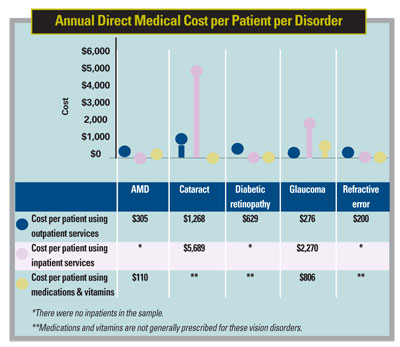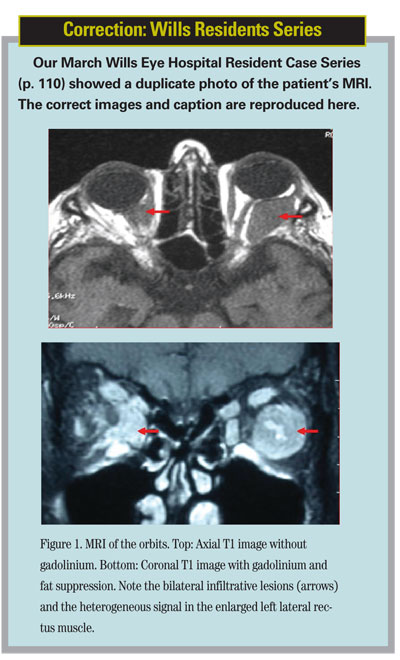In a report released last month, Prevent Blindness America estimated the costs associated with adult vision problems in the

This report marks the third phase of a concerted effort by Prevent Blindness America to address the critical need for better eye health and to ensure that sufficient governmental resources are dedicated to the research, treatment and prevention of eye-related diseases. In 2002, Prevent Blindness America released the "Vision Problems in the
Following that report, the organization announced the "Vision Problems Action Plan" to effectively address the VPUS results. The most recent report brings to light the substantial effect vision problems have beyond physical and emotional implications by analyzing the considerable financial impact vision loss has on the individual, caregivers, the government and insurance premiums. "These astounding numbers underscore the significant need to address the overall impact of vision problems on individuals, their families and our society," said Daniel D. Garrett, PBA's senior vice president. "The goal of this report is to ensure our nation's leaders understand the seriousness of
A team led by David Rein, PhD, of RTI International and the CDC researched the costs to the
Impact to the
Study Explores Contact Lens Dissatisfaction
Refractive surgeons may find no surprises in the data, but a group of researchers at
The authors point out that earlier studies have found that as many as half of contact lens wearers commonly cite dry eye and discomfort related to lens wear. They undertook this study because of a lack of information in the ophthalmic literature regarding specific factors associated with discontinuation of contact lens wear.
In the study, 730 subjects completed a self-administered survey of information about present age and sex, history of contact lens wear, types of lenses worn, age at starting wear, current wearing schedule, self-perceived contact lens satisfaction and contact lens-related problems. Sixty-two percent of the subjects had some experience with contact lenses at some point in their lives. (The authors caution that the university-based sample may make participation in contact lens wear higher than in a more diverse population.) Those who reported any lifetime experience with contact lenses tended to be younger, were female, had an average age of 18 years when initiating lens wear, were soft lens wearers and had spent about 10 years in lenses.
Among their key findings:
• 24 percent of all subjects who had some lifetime experience with contact lenses had since permanently discontinued contact lens wear. Discontinued contact lens wearers (compared with current contact lens wearers) tend to be presently older, male and more likely to have tried both soft and rigid lenses. Soft lens wearers who discontinue lens wear do so faster than rigid lens wearers, which suggests more loyalty to the rigid lens modality and/or more problems (ie, visual, symptoms) with the soft lens modality.
• Among the 344 current lens wearers in the sample, 65 percent deemed the modality to be the ''ideal'' form of visual correction. That leaves 35 percent of the cohort dissatisfied with the modality, the authors conclude. Women were more likely to report dissatisfaction with contact lens wear; men were more likely to discontinue contact lens wear.
• Age at starting lens wear seemed to be a factor in the ultimate prognosis of contact lens wearers. Starting at a younger age was associated with satisfaction and continued wear. This may be explained by the fact that patients who start lens wear younger may have had significant refractive error at a younger age and thus were more motivated to wear contact lenses (compared with spectacle correction).
• Dissatisfied current contact lens wearers are more likely to report ocular symptoms, general problems, visual problems or alternative preference than previous lens wearers. After ocular symptoms, the next most common reason for reporting dissatisfaction or discontinuation of contact lens wear was that the patients preferred a different modality. In fact, 40 percent of the dissatisfied or discontinued cohort of patients reported that they either wanted to have or had had refractive surgery.
• The ocular symptoms ''dryness'' (76 percent of all ocular symptoms reported) and ''discomfort'' (67 percent) were reported most frequently (regardless of being a dissatisfied current lens wearer or previous lens wearer).
AMO Completes IntraLase Buy
With the approval of IntraLase stockholders, Advanced Medical Optics' acquisition of IntraLase Corp. was completed on March 30. AMO had announced a definitive agreement to acquire IntraLase for approximately $808 million in cash in January. Under the terms of the agreement, AMO paid $25 in cash per share of IntraLase stock and the individually determined cash value per share of outstanding stock options.
"We have taken a major step toward defining a new standard of care in laser vision correction," said AMO Chairman, President and CEO Jim Mazzo. "Along with the recently announced acquisition of WaveFront Sciences, AMO now owns the most advanced corneal refractive technologies on the market with the ability to offer a full systems approach that is without peer in the industry. The addition of IntraLase's state-of-the-art femtosecond laser technology to AMO's unmatched portfolio of corneal and cataract products allows us to forge a new path for vision care with a full suite of technologies to address a lifetime of refractive needs."
The acquisition also gives AMO entry into the corneal transplant market with the IntraLase enabled keratoplasty (IEK) technology.
'Scream' for an Ophthalmologist
The Associated Press reported last month that the directors of 



